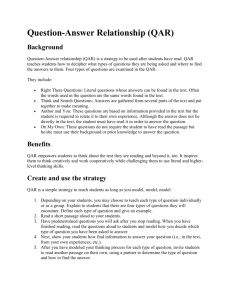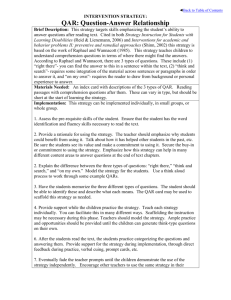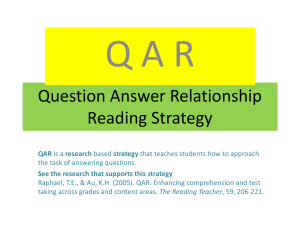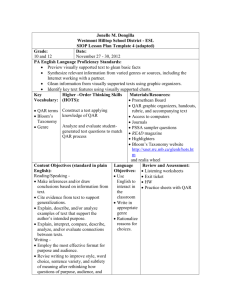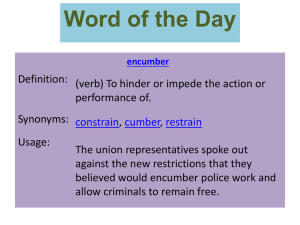Question Answer Relationship PPT
advertisement
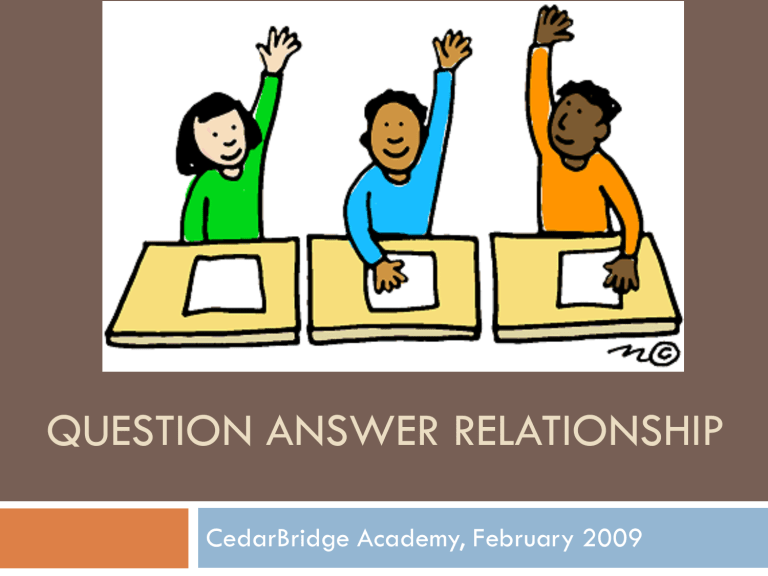
QUESTION ANSWER RELATIONSHIP CedarBridge Academy, February 2009 Do Now: Do you ever feel like you don’t understand a question on a test? If you understood questions better, how would it change your understanding of concepts and performance on tests? QAR Training Our goal is to help you become stronger learners, but you are responsible for the learning… Why focus on Questions? Responding to questions is how you demonstrate that you have learned the required information. Questions help to guide Your learning focus Your interaction with text Identify questions that Model standardized exam questions Stimulate higher level thinking We want you to ask more questions… and learn more! Why use the strategy? Even Einstein asked Questions! Question – Answer – Relationship What type of question is being asked? What kind of thinking is needed to answer? Text Based Questions Right There The answer is in the text. The words used to make up the question and words used to answer the question are found in the same sentence. Think and Search The answer is in the selection, but you need to put together different pieces of information to find it. The answer comes from different places in the selection. Reader Based Questions On My Own The answer is not in the text. You can answer the question without even reading the text. The answer is based solely on your own experiences and knowledge. Author and You The answer is not in the story. You need to think about what you already know, what the author tells you, and how it fits together. Right There Think and Search QAR Author and Me On My Own Let’s Practice… When lighting a match, it is important to follow these steps carefully. First, tear one match out of the matchbook. Second, close the matchbook cover. Third, strike the match against the rough strip on the outside of the matchbook. Finally, after the match has been used blow it out carefully, and be sure it is cool before you throw it away. QAR Examples QAR Author and Me Think and Search Right There On My Own 1) What is the first step in correctly lighting a match? (Right There) 2) Why should you be sure the match is cool before you throw it away? (On My Own) 3) What should you do after a match has been used and it is still burning? (Right There) Let’s Practice… When lighting a match, it is important to follow these steps carefully. First, tear one match out of the matchbook. Second, close the matchbook cover. Third, strike the match against the rough strip on the outside of the matchbook. Finally, after the match has been used blow it out carefully, and be sure it is cool before you throw it away. QAR Examples QAR Author and Me Think and Search Right There On My Own 4) Why should you close the cover before striking the match? (Author and Me) 5) What do you strike the match against to light it? (Right There) 6) Create a short children’s story about how to avoid the dangers of playing with matches. (On My Own) Experiencing the process… Read the article “Bacteria: The Good, the Bad, and the Stinky” Answer QAR questions 1-8, paying close attention to your thinking process. Break: BREAK5 mins Developing Questions “…students can learn to ask the four different types of questions, and the questioning process can be transferred from teacher to learner.” Choose a sample article to work with… With a partner, use the question prompts to write four (4) questions about the article, one for each QAR. Find a pair from another table, compare questions. What did you learn about the types of questions? Think and Share a) Which type of question did you prefer answering? Why? b) How can your new knowledge help you to better understand and respond to questions? The ball is in your corner! Now take what you have learned… and use it to help you in all of your classes.

